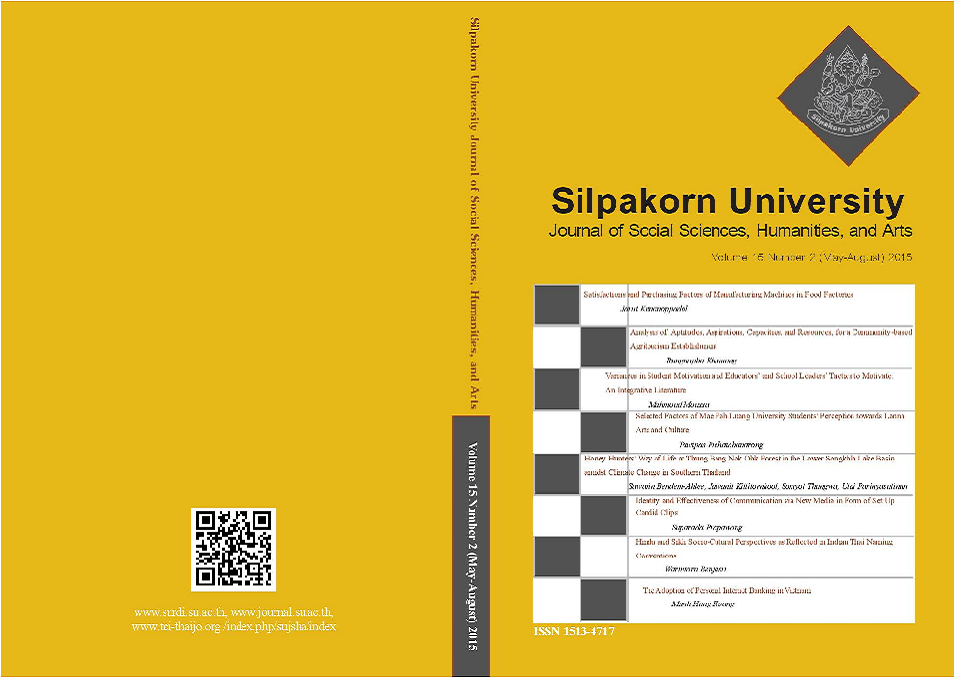Identity and Effectiveness of Communication via New Media in Form of Set Up Candid Clips
Main Article Content
Abstract
The objectives were to analyze the using of new media in theform of set up candid clip that affects the product and presenter, to studythe effectiveness of using new media in the form of set up candid clipin order to increase the circulation and audience satisfaction and to usethe earned information and knowledge to develop the communication forpublicizing and advertising via new media. This research is qualitativeresearch based on questionnaire and in-depth interview from experts.The findings showed the identity, advantages and disadvantages ofcommunication for publicizing and advertising via new media in the formof set up candid clip. The identity is related with the disadvantages thatthe electronic media that computer or mobile device is required includingwith internet and social network and make audience feel deceived. Theadvantage is the ability to reach the specific target group, easy to accessanyplace and anytime in low cost production and can be talk of the townovernight but mostly in short-term. The boundary of this media is therequirement of computer, electronic device, internet and social networkprograms. It should be used as secondary media to support the primarymedia. The specific target group for this kind of communication arefemale, in the age of 31-35 and 41+ and in the level of education ofsecondary education. Set up candid clip effects to the products andpresenters by using this kind of communication. It will be useful for fieldsof publicizing and advertising in the new media forms at the present.
Downloads
Article Details
All rights reserved. Apart from citations for the purposes of research, private study, or criticism and review,no part of this publication may be reproduced, stored or transmitted in any other form without prior written permission by the publisher.
References
Berlo, D. K., Schramm, W. and Bettinghaus, E. P. (1980) The Process of Communication, The Process and Effects of Mass Communication, Persuasive Communication. New York: Holt, Rinehart and Winston.
Blackwood, R. (1993) Persuasion and Propaganda. Lecture given to the graduate students, Faculty of Communication Arts, Chulalongkorn University, Bangkok.
Bove, L. C., Thill, J. V., Dovel, G. P. and Wood, M. B. (1995) Advertising Excellence. New York: McGraw-Hill.
Brembeck, W. and Howell, S. (1976) A Means of Social Influence.New Jersey: Prentice-Hall, Inc.
Cooper, L. (1960) The Rhetoric of Aristotle. New York: Appleton-Century-Croft.
Kotler, P. (1991) Marketing Management: Analysis, Planning, Implementation and Control. New Jersey: Prentice Hall.
Lane, W. R. and Russell, T. (2001) Advertising: A Framework. New Jersey: Prentice-Hall.
McQuail, D. (2005) Mass Communication Theory. Sage Publications Limited.
O’Guinn, T. C., Allen, C. T. and Semenik, R. J. (2000) Advertising.Ohio: South-Western College Publishing.
Patrick, D. (2011) New Media Communication Model. [Online URL: https://patrick-drake.com/topics/blog/new-media-communication-model] accessed on May 1, 2015.
Pilantaowat, O. (2006) Communication for Persuasion. Press of Chulalongkorn University.
Rosenerg, M. J. and Hovland, C. I. (1960) Cognitive, Affective, and Behavioral Components of Attitudes. New Haven: Yale University Press.
Scheidel, T. (1973) Speech Communication and Human Interaction. Illinios: Scott Foresman and Company.
Wongmonta, S. (1997) Advertising and Sales Promotion. Tera Film and Textile Co.
Wongsumaytorn, K. (2006) Advertising Process. Bangkok: Suan Sunandha Rajabhat University.


